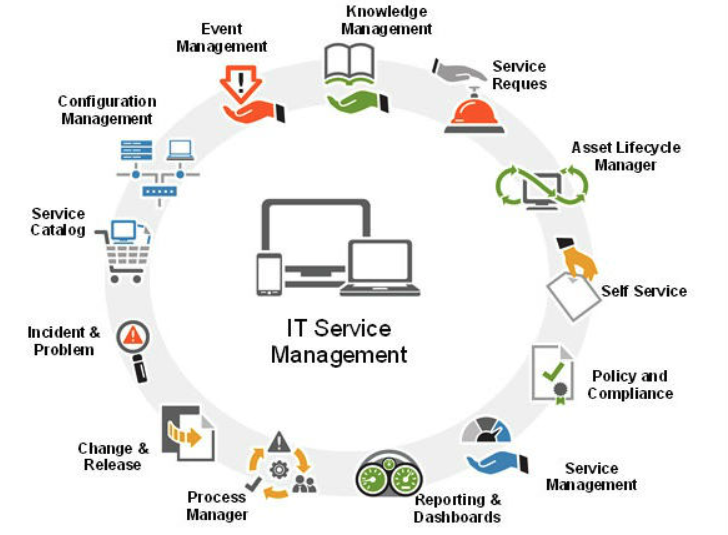
What is ITSM System (Image by Spiceworks)

What is ITSM System (Image by Spiceworks)
IT service management system is a set of interrelated or interacting elements that establishes policies, processes, and procedures for designing, delivering, controlling, and improving IT services that provide value to the customer while meeting agreed-upon service levels.
ITSM, the fundamental idea of the system, provides effective IT service delivery, significantly impacting overall business operations.
At the same time, ITSM focuses on customer-oriented IT services, emphasizing service-level agreements and IT functions.
Benefits of ITSM include improved IT service management focus, more predictable infrastructure, enhanced consultation with IT groups, smoother service level agreement negotiation, and seamless end-to-end service.
Implementing ITSM, particularly frameworks like ITIL, requires careful planning and execution, involving considerable financial resources and change management.
In this article, we will discuss how ITSM systems work and their positive impact on your business as well as on your customers.
An IT Service Management System (ITSM) is a framework that guides how IT services are managed within an organization to align with customer needs and business objectives.
The IT service management system connects IT services to customer requirements and other organizational aspects. The IT Infrastructure Library (ITIL) is a widely used ITSM framework.
IT Service Management (ITSM) is the umbrella discipline describing how IT services are managed to meet business and customer needs.
ITIL is a specific framework or set of best practices within ITSM that guides organizations on how to efficiently and effectively manage their IT services.
ITIL V4, the latest version, offers a more practical and adaptable approach for modern digital businesses. It focuses on practices rather than prescriptive procedures, allowing customization to meet specific organizational needs.
ITIL’s life cycle includes stages like Service Strategy, Service Design, Service Transition, Service Operation, and Continual Service Improvement. These stages help manage IT services effectively and align them with business goals.
IT management service providers use ITSM frameworks like ITIL to ensure their services meet customer expectations and contribute to the business’s overall success.
Two things are hard to avoid when discussing IT service management systems: tools and frameworks.
ITSM tools or software help implement IT service management practices within an organization. It includes specific features and functionalities like ticketing, incident management, and asset tracking to manage IT services and support.
ITSM framework is a set of guidelines, best practices, and processes for managing IT services. It provides a structured approach to IT service management, aligning IT services with business objectives and customer needs. Examples include ITIL, COBIT, and MOF.
ITSM frameworks, such as ITIL or COBIT, provide structured guidelines and best practices for managing IT services effectively.
They outline processes and principles to align IT services with business goals and customer needs.
ITSM services, on the other hand, are the practical implementation of these frameworks within an organization.
They encompass the actual IT service management activities, tools, and processes that adhere to the principles laid out by the frameworks.
Here are five examples of IT service management tools available in our market today:
For a more extensive explanation, kindly take a look at our detailed guide to choosing the right IT service management tools.
Here are five examples of IT Service Management (ITSM) frameworks widely used in the global IT landscape
An ITSM ticketing system is a centralized hub for managing IT-related tasks, such as incidents, problems, and service requests. It functions through several phases:
The implementation of an ITSM ticketing system involves a holistic needs assessment, vendor selection, customization, data migration, training, testing, and a phased rollout.
Challenges in implementation include resistance to change, integration complexities, and ensuring data accuracy.
Overcoming these hurdles can enhance operational efficiency, transparency, accountability, and customer satisfaction in IT service delivery.

Best practices in ITSM systems for enterprises focus on a holistic approach, where each practice complements and strengthens the others, enhancing overall IT service management.
Firstly, focusing on the end users rather than just the processes ensures that the ITSM implementation benefits the users and customers.
This approach aligns the ITSM processes with the organization’s goals, improving overall service delivery.
Preparing for a cultural shift in the organization is vital, as ITSM implementation can significantly change workflows and practices.
Employees must be trained and comfortable with these changes to ensure successful implementation.
Remembering that ITSM implementation is a continuous process is essential. It’s not a one-time installation but a series of steps that require patience and structured execution over time. Qualified professionals should manage this to ensure effective implementation.
Continuous evaluation for improvement is crucial. Regular feedback and thorough reports help organizations understand what’s working and needs improvement.
This personalized approach ensures the ITSM system fits the organization’s unique needs.
Automating repetitive processes can reduce human error, freeing staff to focus on more strategic tasks.
Automation enhances efficiency and prevents minor mistakes from leading to more significant issues.
Utilizing available data to create meaningful metrics helps ITSM professionals better understand the organization’s IT processes.
This understanding aids in developing insights and metrics that support the ITSM implementation process.
Integrating the entire organization with the IT department is necessary for successful ITSM implementation.
This integration ensures that all employees receive quality service and their concerns are promptly addressed, improving collaboration and operational efficiency.
Prioritizing certified ITSM professionals is beneficial as their expertise and knowledge in ITSM ensure effective changes and scalable processes, managing the cultural shift accompanying ITSM implementation.
When interwoven, these best practices create an effective ITSM system that improves IT services and aligns them with the broader business objectives.
Implementing these practices requires a combination of strategic planning, continuous improvement, and skilled professionals to navigate the cultural and operational changes within the organization.
On a final note, the focus is always on optimizing processes to align IT services with the overarching goals of an organization.
This article explores the complexities of ITSM systems, emphasizing the significance of frameworks such as ITIL, the features of ticketing systems, and the need to adopt best practices for enterprise-level ITSM implementations.
The importance of customer-focused IT services, efficient service delivery, and the value of ongoing improvement highlights the critical role that ITSM plays in improving your business operations and customer satisfaction.
This analysis seamlessly brings us to Octobits, a tool for organizations aiming to optimize their IT service management systems.
Octobits is an all-in-one consolidated dashboarding application tailored for Managed Service Providers (MSPs) and IT departments. It enables a comprehensive and centralized view of an organization’s IT ecosystem.
This integration facilitates efficient monitoring, analysis, and management of IT infrastructures, thereby enhancing productivity and operational efficiency.
The platform offers a range of features to simplify IT management, including a unified login system for all IT systems, streamlined billing information, comprehensive reporting, and consolidated alerts for all IT services.
Furthermore, Octobits seamlessly integrates with major IT vendors, including Datto Autotask, Microsoft 365, Azure, AWS, CrowdStrike, and Proofpoint. This ensures businesses can easily access and manage their IT services, reducing complexity and enhancing security.
Octobits provides tools, frameworks, and technologies that create a cohesive environment for IT teams. This enables your business to overcome challenges and benefit from an effective IT service management system.